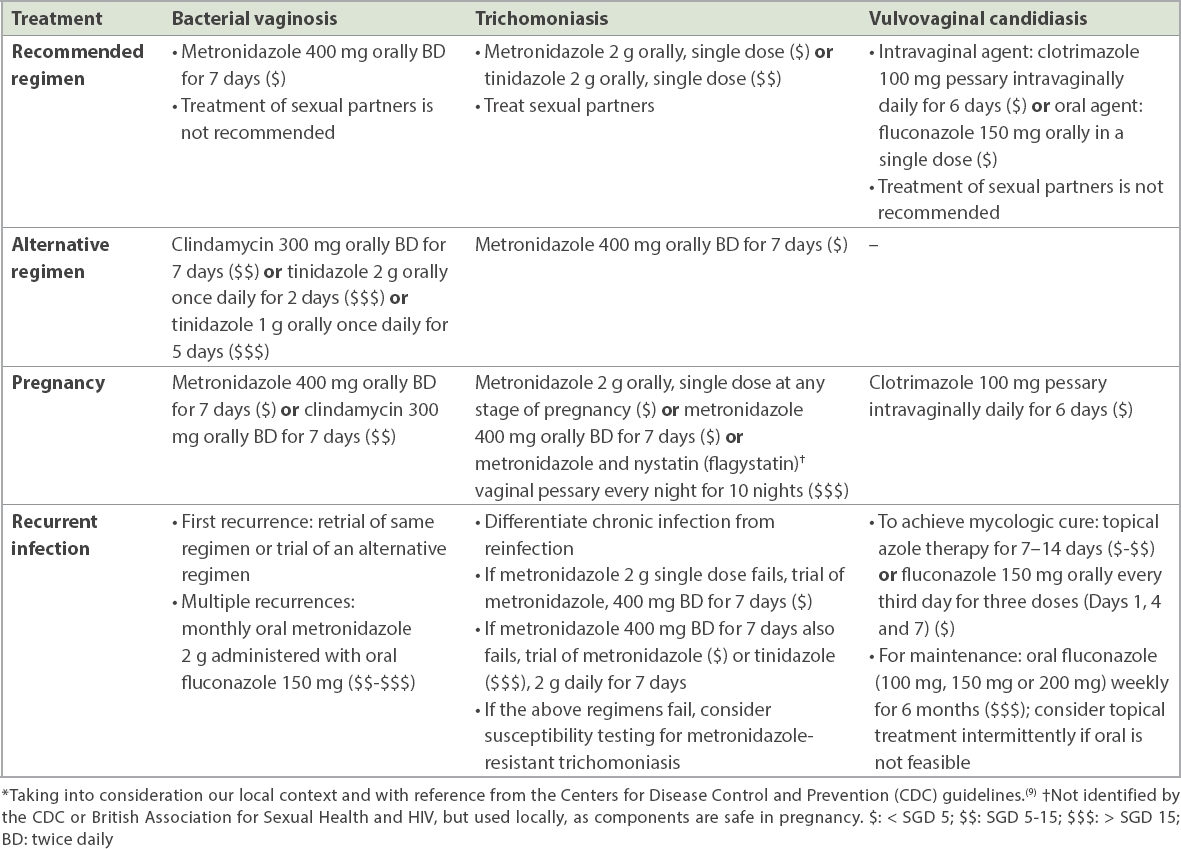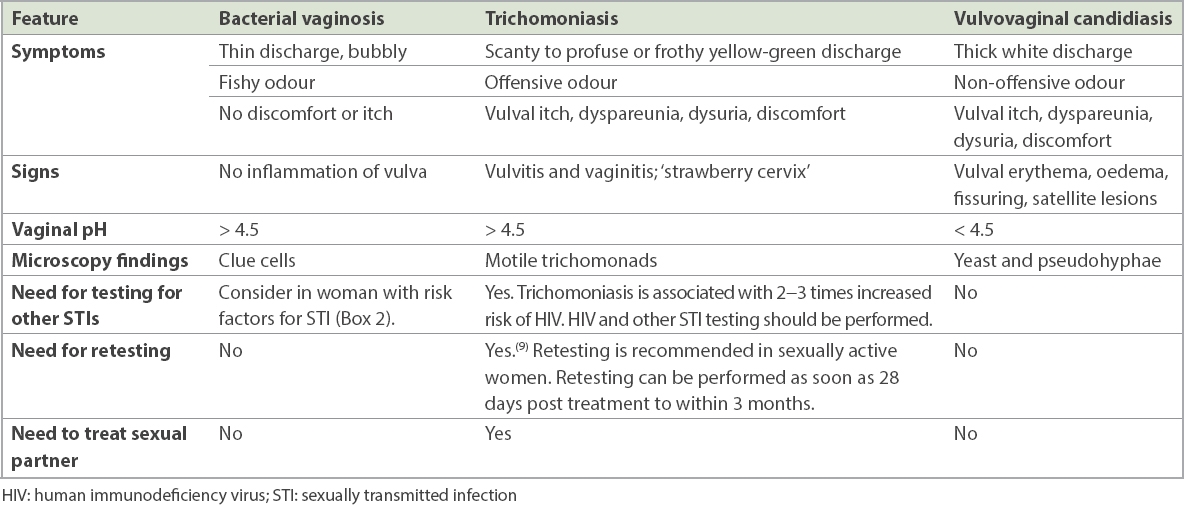Miss Lim, a 26-year-old business executive, came to your clinic for vaginal discharge of over one week’s duration. A month ago, she had been treated with one dose of oral fluconazole for a vaginal yeast infection and had seen symptomatic improvement. On this occasion, she reported the same symptoms of itch and vaginal discharge. This was her third episode in six months. She was sexually active with one stable male partner. She thought the yeast infection had recurred and requested the same treatment.
WHAT IS ABNORMAL VAGINAL DISCHARGE?
Vaginal complaints account for approximately 10 million primary care visits annually in the United States alone.(1) It is the most common gynaecological complaint seen by primary care doctors, yet rates of misdiagnosis are high. Vaginal discharge may be a normal physiologic occurrence or a pathological manifestation. In Singapore, we are likely to be underdetecting the number of women with abnormal vaginal discharge in primary care, as it is often viewed as a taboo complaint or embarrassing in Asian cultures.(2)
Normal vaginal discharge
Normal physiological discharge changes with the menstrual cycle. The character of the discharge tends to be clearer with a stretchable consistency around ovulation, then may be thicker and slightly yellow during the luteal phase. Normal healthy discharge should not be associated with symptoms such as itching, redness and swelling, and does not have a strong odour.(3) Vaginal discharge can increase during higher oestrogen states, such as ovulation, the luteal phase, puberty and pregnancy, and with oestrogen-based therapies such as combined hormonal contraception and hormone-replacement therapies. Normal vaginal discharge is found in 10% of those who present with vaginal discharge.(4)
Abnormal vaginal discharge
Abnormal vaginal discharge is characterised by a change in colour, consistency, volume or odour, and may be associated with symptoms such as itch, soreness, dysuria, pelvic pain, intermenstrual bleeding or postcoital bleeding.(5) An important follow-up question to ask is whether the vaginal discharge is significantly altered from the woman’s usual pattern.(3) If the vaginal discharge has a significant change in colour and odour, contains blood or causes itch or discomfort, it is less likely to be physiological in nature.
WHAT CAUSES SHOULD BE CONSIDERED?
Abnormal vaginal discharge is most commonly caused by infection. 70% of all causes are associated with bacterial vaginosis (BV), vulvovaginal candidiasis (VVC) or trichomoniasis (TV).(6) Of the three causes mentioned, BV is the most common and accounts for up to 50% of all infections.(5,7)
Cervicitis is another important cause of vaginal discharge, with Chlamydia trachomatis and Neisseria gonorrhoeae being the most common pathogens isolated. Cervicitis should be suspected in sexually active women found to have purulent endocervical discharge and easily induced cervical bleeding.(8)
Non-infectious causes include atrophic vaginitis, contact dermatitis due to allergic or irritant causes, foreign body vaginitis (e.g. retained tampon or condom), cervical polyps, fistulas and genital tumours (e.g. tumours of the vulva, vagina, cervix, fallopian tube and endometrium).(3)
A diagnostic aid to vaginal discharge
Abnormal vaginal discharge can also be categorised into two broad categories: inflammatory and non-inflammatory. This dichotomy can help physicians narrow down the possible aetiology based on the physical signs.
Inflammatory vaginitis is often associated with physical examination findings such as erythema and oedema and the presence of polymorphonuclear neutrophils (PMNs) on microscopic examination. This is most commonly seen in TV and VVC, but can also be found in atrophic vaginitis, desquamative inflammatory vaginitis and multimucosal erosive disease (e.g. erosive lichen planus and pemphigus vulgaris). On the other hand, non-inflammatory conditions do not have the aforementioned signs and are not associated with PMNs on microscopy. BV is the most common example.(7)
WHAT CAN I DO IN MY PRACTICE?
A good history should include the woman’s last menstrual period, characterisation of the vaginal discharge, associated symptoms, and sexual, medical and drug history including recent antibiotic use and type of contraceptive use. One should also assess for the possibility of a foreign body in situ and if there was any surgery or instrumentation to the genital region recently. It should be standard practice to offer a vagina and speculum examination to all women presenting with vaginal discharge, unless the woman refuses or is a virgo intacta.(5) If a woman has fever, lower abdominal pain or if an examination reveals lower abdominal tenderness, mucopurulent cervicitis or cervical excitation, one should consider upper genital tract pathology.
In most local primary care settings, an in-house microscope may not be available, and specimens of vaginal discharge for investigations must be sent to an external laboratory. If a lower genital tract infection is suspected, point-of-care testing can aid diagnosis based on the pH levels of the discharge. Sample vaginal secretions are obtained from the lateral vaginal walls using a swab and then applied to a narrow-range pH paper (pH 4–7). Vaginal pH < 4.5 is suggestive of VVC and pH > 4.5 is suggestive of BV or TV. However, it is not possible to distinguish between BV and TV using the pH test alone. Narrowing of the likely diagnosis can hence be made using a combination of clinical history and physical signs, together with the pH findings.(5,7)
A high vaginal swab for microscopy (wet mount and Gram stain), culture and sensitivity should be considered to confirm the diagnosis if the woman has the following characteristics: chronic or recurrent symptoms (
Box 1
Definitions of chronic and recurrent symptoms:

Pregnant women can have an exaggeration of physiological vaginal discharge and asymptomatic vaginal microbiome. If they present with abnormal vaginal discharge, they should be referred back to their O&G specialist for a review. In the tertiary care setting, pregnant women are antenatally screened for Group B Streptococcus, but colonisation would not be expected to cause vaginal discharge. Any further testing is only performed in cases of preterm premature rupture of membrane, threatened preterm labour or suspected sexually transmitted infections (STI).
Treatment
For VVC, the choice of treatment can be based on the woman’s preference, with single-dose oral fluconazole being as effective as topical azoles. However, an exception should be made when the woman is pregnant and the treatment of choice is a topical azole, as oral fluconazole is contraindicated in pregnancy. For the treatment of BV in pregnancy, oral metronidazole or clindamycin can be used, and for TV in pregnancy, oral metronidazole or metronidazole and nystatin (flagylstatin) vaginal pessary. For breastfeeding mothers, oral metronidazole 400 mg twice daily for seven days should be used instead of 2 g single high-dose metronidazole, which is not recommended for this group. Treatment of the three most common vaginal infections is detailed in
Table II
Treatment regimens for the three most common causes of vaginal discharge.*

Women should be advised to avoid alcohol consumption during treatment for up to 24 hours after completion of metronidazole or 72 hours after completion of tinidazole to reduce the possibility of a disulfiram-like reaction. Women with TV should be told to abstain from sexual intercourse until treatment is completed and symptoms have resolved, as it is sexually transmissible.(3,9)
Patient education
Women should be advised to avoid tight-fitting synthetic clothing, local irritants such as perfumed products and soap gels, and vaginal douching.(3) There is no clear and consistent evidence across currently published studies regarding the role of probiotics for vaginal health.(10) The use of topical azole formulations can weaken latex condoms and diaphragms. This risk should be mentioned to the woman prior to starting these medications.
Screening for sexually transmitted infections
It is recommended to screen for STI in women who are diagnosed with TV.(9) Women who are at high risk of STI(5) (
Box 2
Risk factors for sexually transmitted infections (STI):

Recurrence of vaginal infection
A subgroup of women present with a recurrence of vaginal infection after the first treatment. This group is asymptomatic in between discrete attacks. The estimated recurrence rate in the literature is 5% for VVC infection (commonly defined as four or more culture-proven episodes in a year),(9,11) 12.5%–18.5% in TV(12) and up to 50% for BV (also defined as three or more confirmed episodes using Amsel’s criteria in a few studies) within a one-year period.(13) However, these statistics have an inherent limitation due to a few reasons: varying definitions of what recurrence means, use of over-the-counter medications and frequent empirical treatment of vaginal infections without diagnostic confirmation by physicians.
It is important to identify potentially reversible factors that could predispose the woman to recurrent infections such as uncontrolled diabetes mellitus and immunosuppression. Women with a history of recurrent BV and who are keen on contraception should be advised to use hormonal methods of contraception rather than intrauterine devices that can increase colonisation and prevalence of BV.(14)
If standard treatment strategies fail or symptoms recur, a referral should be considered, as a fungal culture can be performed in hospital settings.
Box 3
Refer to a gynaecologist if the following conditions or diagnoses are present:

TAKE HOME MESSAGES
- Vaginal discharge can be either a normal physiologic occurrence or a pathological manifestation. It is important to differentiate between the two during the clinical consultation. A history of a change from the usual pattern of vaginal discharge is an important differentiating factor and should be explored with the woman.
- Inflammatory features such as erythema and oedema during the physical examination may be helpful in narrowing the causes of the vaginal discharge.
- The use of narrow-spectrum pH paper as a point-of-care tool, if available, can help with the assessment of vaginal infection. High vaginal swabs for microscopy (wet mount and Gram stain), culture and sensitivity should be considered in those with chronic or recurrent presentations.
- STI testing is recommended in high-risk sexually active woman or those with TV.
- Referral to a gynaecologist should be considered if there is a history of recent instrumentation or surgery of the genital tract, retained foreign body, cervical ectopy or polyp, or suspicion of tumour on examination; or in women with symptoms of upper genital tract infection or recurrent vulvovaginal candida infections, pregnant women with abnormal vaginal discharge, or women who have failed routine treatment strategies.
You examined Miss Lim and found white, curdy vaginal discharge that was not foul-smelling. In view of her previous episodes, you took a high vaginal swab and treated her empirically with a single dose of oral fluconazole 150 mg. She saw you again a few days later to review her results, which were positive for candidiasis. Her symptoms had since improved. She asked you if any medications could prevent recurrence. You explained that no supplements or medications have been proven to reduce vaginal infections. However, you advised her to avoid wearing tight-fitting synthetic clothing, using perfumed products and soap gels, and performing vaginal douching. You advised her to return to see you if the symptoms recur and not ‘doctor-hop’ or use over-the-counter treatments. Miss Lim agreed to the treatment plans and promised to return if the vaginal discharge recurs.
SMJ-61-301.pdf



